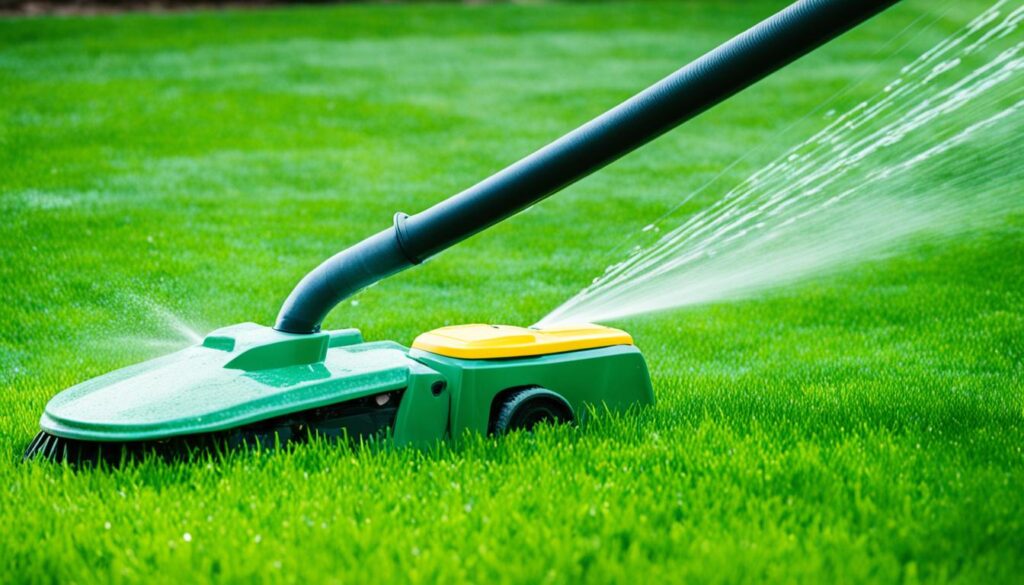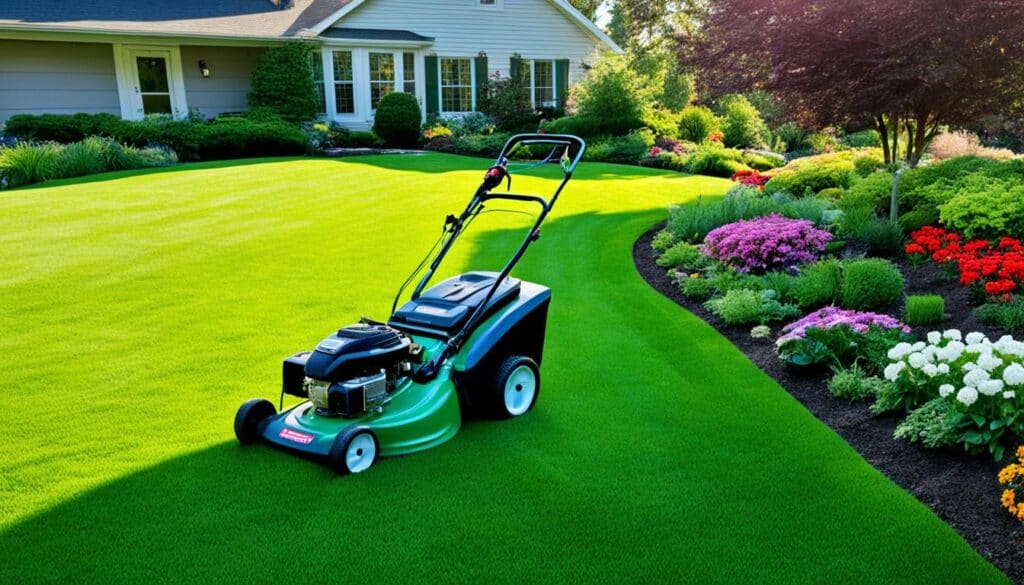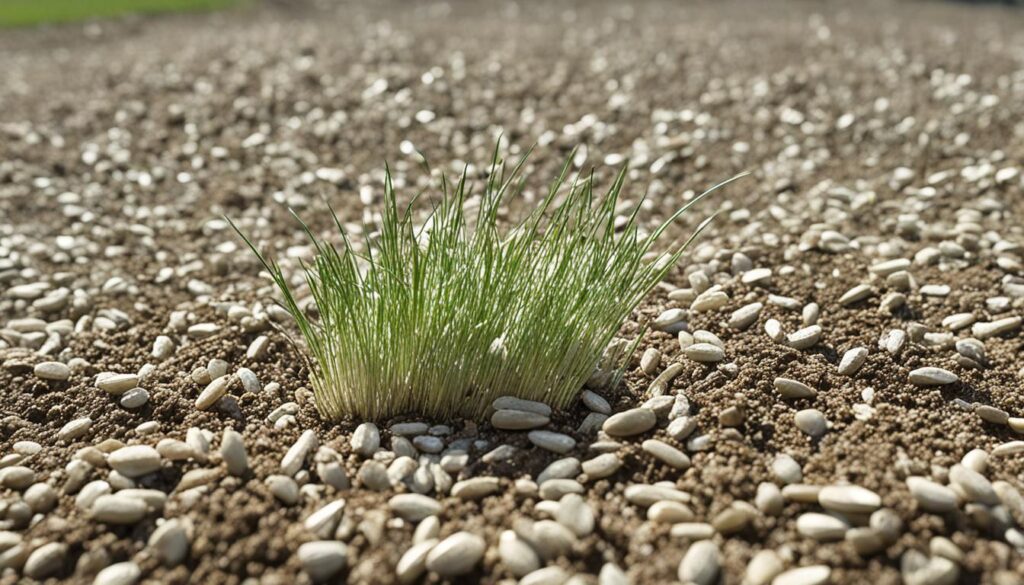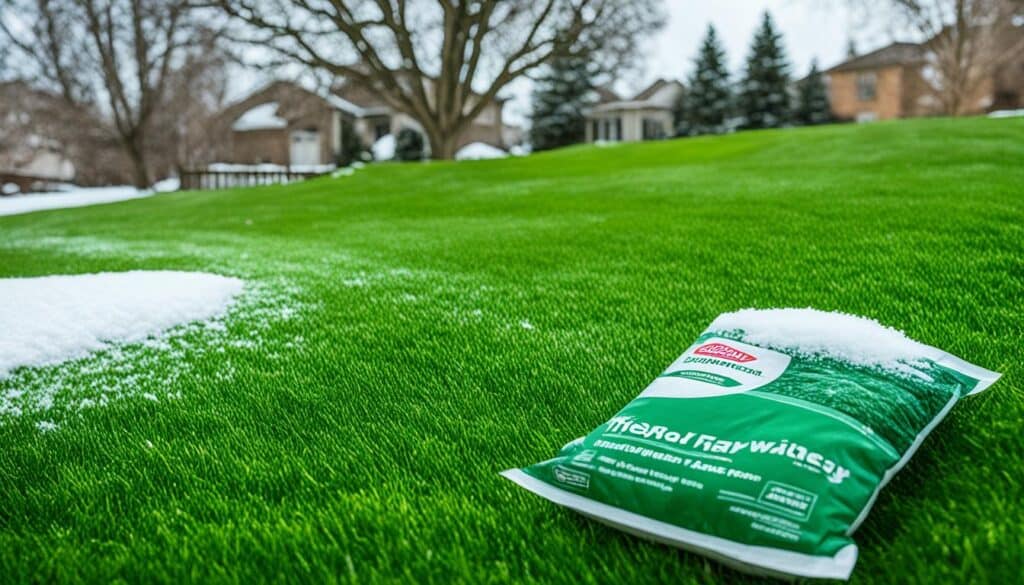Ever wondered, “How long should I wait to mow my lawn after weed control treatments?” Many homeowners ask this to keep their lawns lush and weed-free. The answer is not simple, as the right time to mow after treatment varies.
Timing is key in lawn care after weed control. Mowing too soon can reduce the effectiveness of herbicides. Waiting too long can make your lawn overgrow, needing more work to keep it in check. So, what’s the best time to mow after using herbicides?
We’ll look into how lawn treatments affect grass growth. We’ll see the recommended waiting times for products like Strike 3, Dismiss, and Q-4 Plus. We’ll also talk about how grass type and weather can change when you should mow. Knowing this will help you make better lawn care choices.
Key Takeaways:
- Wait at least 24 hours after applying broadleaf weed control before mowing for optimal herbicide translocation.
- Some herbicides, like Strike 3, recommend avoiding mowing two days before and after application.
- Different herbicides target specific weeds, so get to know the products you use.
- Grass species and weather conditions can affect the waiting period for mowing after overseeding.
- Proper mowing techniques, such as adjusting blade height and handling clippings, are essential for maintaining a healthy lawn post-treatment.
Understanding Lawn Treatments and Their Impact on Mowing
Keeping your lawn green and lush requires knowing about lawn treatments and their effects on grass. It’s key to know how to care for your lawn after weed treatment and when to mow after applying chemicals. A fertilization program helps your lawn get the nutrients it needs all year.
Types of Lawn Treatments
There are many lawn treatments for different needs, like:
- Weed control treatments
- Fertilization treatments
- Insect control treatments
- Fungicide treatments
- Soil amendment treatments
Each treatment is important for a healthy lawn. But, remember, when you apply these treatments, it can change your mowing schedule.
How Lawn Treatments Affect Grass Growth
Lawn treatments, especially fertilizers, give your grass the nutrients it needs to grow strong. These nutrients help the roots and blades of grass. But, it takes time for the grass to absorb them, and cutting your lawn too soon can mess up this process.
Joining a fertilization program is a great move for your lawn. These programs protect your lawn all year, making sure it gets the right nutrients every season.
Granular fertilizers usually don’t get affected by mowing. But, mowing too soon after weed control can hurt its effectiveness. Weed killers work by going through the plant’s leaves. So, wait a bit before mowing to let the treatment work well.
| Treatment Type | Recommended Waiting Time Before Mowing |
|---|---|
| Weed Control | 24-48 hours |
| Fertilization | 24-48 hours |
| Insect Control | 24 hours |
| Fungicide | 24 hours |
| Soil Amendment | Immediate mowing allowed if clippings are left on the lawn |
Knowing about lawn treatments and their effects helps you plan your mowing schedule better. This way, you can keep your lawn healthy and beautiful. It also makes sure the treatments work as they should.
Preparing Your Lawn for Treatment
Before you apply any lawn treatments, make sure your lawn is ready. Proper preparation boosts the treatment’s effectiveness and helps your grass grow healthier. Mowing is key, as it affects how well the treatment works.
Mowing Before Applying Lawn Treatments
It’s best to mow your lawn right before you fertilize it. This ensures the fertilizer is absorbed well by the grass. But, wait 24 hours before weed control treatments.
Mowing too close to an herbicide treatment can reduce its effectiveness. Broadleaf weed control products need to reach the plant’s foliage to work. Cutting your lawn too short before treatment can stop the product from targeting weeds.
Ideal Grass Length for Lawn Treatments
For the best results, keep your grass at the right height. In Northern Virginia, mow once a week during the growing season. This keeps your lawn looking good and helps it grow strong and weed-free.
Keep grass blades at 3.5 to 4 inches long. This length prevents stress, which can turn your lawn yellow or brown. Mowing too short stresses the grass, making it hard for it to absorb nutrients from treatments.
| Mowing Timing | Recommended Action |
|---|---|
| 24 hours before fertilization | Mow to ideal length for optimal absorption |
| 24 hours before weed control | Avoid mowing to ensure sufficient leaf surface area |
| During growing season | Mow once per week to maintain 3.5-4 inch grass length |
Follow these guidelines for mowing after lawn treatments and keep your grass at the right height. This prepares your lawn for treatments, leading to better results. A well-kept lawn is stronger and more responsive to care, making your outdoor space healthier and more vibrant.
Optimal Waiting Time for Mowing After Fertilization
Timing is key when it comes to a lush, healthy lawn. After fertilizing, wait the right amount of time before mowing. Cutting too soon can mess up growth and waste nutrients.
The best time to mow after fertilizing depends on the fertilizer type. Liquid fertilizers work fast, so wait a few hours. Granular fertilizers take longer, needing 24 to 48 hours before mowing.
Mowing too soon after fertilizing can cause patchy grass. This leads to uneven growth and wasted fertilizer. Give your lawn time to absorb the nutrients well.
Not waiting the right time can harm your lawn. Mowing too soon can cause:
- Unhealthy grass
- Wasted fertilizer
- More time, money, and effort on lawn care
| Fertilizer Type | Recommended Waiting Time |
|---|---|
| Liquid Fertilizer | 2-4 hours |
| Granular Fertilizer | 24-48 hours |
The best waiting time for fertilizing after mowing changes with location and climate. In Tennessee, wait 24 hours to a few days. Always check the fertilizer instructions and consider the weather for your area.
Follow these guidelines for cutting your lawn after weed control and herbicides. This way, your lawn gets the nutrients it needs for a beautiful, healthy look.
How Long to Wait to Mow After Lawn Treatment
After applying a lawn treatment, let the product work for a bit. The time you wait before mowing depends on the treatment type and the maker’s instructions. Usually, wait 24 to 48 hours after a liquid treatment to get the best results.
Factors Influencing Waiting Time
Several things affect how long you should wait before mowing your lawn after a treatment. These include:
- Type of treatment (herbicide, fertilizer, or pesticide)
- Application method (liquid or granular)
- Weather conditions (temperature, humidity, and rainfall)
- Grass type and growth rate
For granular fertilizer, you can mow right after applying, if you water the lawn well. But, with liquid treatments like herbicides, wait for the product to soak in before cutting the grass.
Risks of Mowing Too Soon After Treatment
Mowing too soon after a treatment can lead to problems:
- Reduced effectiveness of the treatment
- Uneven distribution of the product
- Damage to the grass blades
- Increased risk of exposure to the chemicals
Waiting 24 hours before a weed control treatment helps it work better. The herbicide needs time to get into the weeds and reach their roots. Cutting the grass too soon can cut off the treated parts, reducing the product’s effect.
| Treatment Type | Recommended Waiting Time |
|---|---|
| Liquid herbicide | 24 to 48 hours |
| Granular fertilizer | Immediately (after watering) |
| Pesticide | Follow manufacturer’s instructions |
Always read and follow the manufacturer’s instructions for the specific product you are using. They will provide the most accurate information on how long to wait before mowing your lawn after a treatment.
Waiting the right amount of time before mowing ensures your lawn treatment works well. This helps keep your lawn healthy and green all season.
Mowing Techniques for Recently Treated Lawns
When you need to mow your lawn after using chemicals or weed treatments, it’s key to do it right. The right mowing methods not only keep the treatment effective but also keep your grass healthy and looking good.
Adjusting Mower Blade Height
Setting the right blade height is crucial when mowing a lawn that’s been treated. Don’t cut more than one-third of the grass in one go. This approach reduces stress on the grass, especially after a chemical treatment. Cutting too much can weaken the grass, making it more prone to damage and disease.
Over-mowing stresses grass, making it more vulnerable to damage. It is advised not to cut more than a third of the grass blade at a time to promote a healthy lawn.
Also, make sure your mower blades are sharp. Dull blades tear the grass instead of cutting it cleanly. This can lead to a rough look and increase the chance of pests or diseases.
Handling Grass Clippings
Usually, it’s best to leave the grass clippings on the lawn after mowing. They work as a natural mulch, keeping the soil moist and rich in nutrients. They also add a bit of organic nutrients to the soil.
But, if you’ve used a weed killer or herbicide, check the product’s instructions about grass clippings. Some treatments might require bagging the clippings to stop weed seeds from spreading or to keep them out of compost piles.
| Mowing Technique | Benefits |
|---|---|
| Adjusting blade height (max 1/3 of grass length) | Minimizes stress on grass, promotes healthy growth |
| Using sharp mower blades | Clean cuts, reduces risk of disease and pest infestation |
| Leaving clippings on the lawn | Acts as mulch, retains moisture and nutrients |
By using these mowing tips and sticking to the recommended schedule after applying chemicals, you’ll help your lawn bounce back and stay healthy and beautiful all season.
Watering Your Lawn After Treatment and Before Mowing
After you treat your lawn with weed and feed, it’s key to water and mow at the right times. Following the product’s guidelines is crucial for the best results. This ensures the treatment works well and doesn’t harm your grass.

It’s best to water your lawn in the afternoon, when the sun is less intense. This helps the grass recover from the stress of being cut. Also, wait about an hour after mowing to water. This lets the grass settle and the cut blades seal.
Optimal watering time after mowing is crucial to help the grass recover from mowing stress and reach the roots effectively.
When deciding when to mow after treating your lawn, think about the treatment type and the product’s instructions. Some treatments need you to wait longer before mowing. This lets the product work well in the grass. Here are some general guidelines for mowing after common lawn treatments:
- Weed and feed: Wait at least 24 hours after application before mowing.
- Fertilizer: Wait 24-48 hours after application before mowing.
- Herbicides: Wait at least 7 days after application before mowing.
- Insecticides: Wait at least 24 hours after application before mowing.
| Lawn Treatment | Waiting Time Before Mowing |
|---|---|
| Weed and Feed | 24 hours |
| Fertilizer | 24-48 hours |
| Herbicides | 7 days |
| Insecticides | 24 hours |
Regular mowing and watering keep your lawn strong and healthy, especially in tough climates like Florida. But, don’t overwater or water during the hottest part of the day. This can cause fungal growth and other problems. If your lawn looks dry after mowing, it might need more water. But, make sure to water correctly to avoid harming your lawn.
Signs Your Lawn is Ready for Mowing After Treatment
After using herbicides or weed control on your lawn, wait before mowing. This ensures the best results. Knowing when it’s safe to mow and following the right lawn cutting guidelines will keep your lawn healthy and lush.
Visual Indicators of Readiness
One way to know your lawn is ready for mowing is to look at the grass blades. Wait until they reach 3 to 4 inches tall. This usually takes 2 to 3 weeks, depending on the grass type, soil, and weather.
When it’s time to mow, the grass should look strong and upright. It should be a healthy green color, not yellow or brown. This means the treatment didn’t stress the grass, and it’s not too early to mow.
Testing Grass Resilience
Another way to check if your lawn is ready is to test the grass resilience. Pull a few blades gently in different spots. If they spring back quickly, it’s safe to mow. If they don’t bounce back, wait a day or two before checking again.
Also, check the soil moisture before mowing. Don’t mow when it’s too wet or soft. This can harm the roots and cause soil compaction. Mow when the grass is dry to avoid damaging new shoots.
| Indicator | Ready for Mowing | Not Ready for Mowing |
|---|---|---|
| Grass Height | 3-4 inches tall | Less than 3 inches tall |
| Grass Color | Consistent, healthy green | Yellowing or browning |
| Blade Resilience | Springs back easily when tugged | Pulls out easily or doesn’t recover shape |
| Soil Moisture | Dry | Excessively wet or soft |
When you start mowing, use a sharp blade for a clean cut. Set the mower to about three inches for the first few cuts. This helps avoid stressing the new grass. By following these guidelines and waiting for the right time, you’ll have a beautiful, healthy lawn.
Maintaining a Healthy Mowing Schedule Post-Treatment
After applying lawn treatments, it’s key to keep a regular mowing schedule. This helps your lawn stay healthy and look great. Try to mow your lawn once a week when it’s growing, keeping the grass 3 to 4 inches tall. This height is perfect for common Midwest grass types like Kentucky bluegrass and perennial ryegrass.

Be careful not to cut off more than one-third of the grass in one mowing. Cutting too much can stress the grass and slow its recovery. If you want your lawn to be 3 inches tall, cut it before it gets to 4.5 inches. This keeps your grass strong and healthy after weed control.
Using sharp mower blades is also important. They cut the grass cleanly, saving water and helping it grow better. Leaving the clippings on the lawn acts like a natural fertilizer, improving soil quality. This is great for fighting weeds and keeping your lawn healthy.
| Mowing Tip | Benefit |
|---|---|
| Mow once a week during growing season | Maintains consistent grass growth and health |
| Maintain grass height of 3 to 4 inches | Ideal for common Midwest grass species |
| Remove no more than 1/3 of leaf tissue per mowing | Avoids stressing the grass plant |
| Use sharp mower blades | Results in cleanly-cut grass blades and conserves water |
| Leave grass clippings on the lawn | Provides natural fertilizer and improves soil quality |
To make your mowing schedule even better, up the mowing height by an inch in mid-summer. This helps your lawn handle the heat and dry winds better. Also, change your mowing pattern and direction often to avoid damaging the soil and slowing down your lawn’s recovery.
Remember to time your mowing with any extra fertilizing or weed control, waiting 24 to 48 hours after treatments.
By following these tips, your grass will stay healthy, green, and weed-free all season. Keeping up with proper mowing is crucial for a beautiful lawn that makes your outdoor space look great.
Common Mistakes to Avoid When Mowing After Lawn Treatment
When you mow your lawn after using weed killers or herbicides, it’s key to wait as suggested. This ensures the treatment works well and keeps your lawn healthy. Here are some mistakes to skip when cutting your grass after a treatment.
Mowing Too Short
Many homeowners cut their lawn too short right after weed control. This can stress the lawn and stop it from recovering. To keep your lawn healthy, follow the right cutting guidelines. Keep your grass at 3.5 inches tall.
Mowing When Grass is Wet
Don’t mow your lawn when it’s wet from watering. This can lead to an uneven cut and damage. Wait for the grass to dry for a clean, even cut and to avoid spreading herbicides.
Using Dull Mower Blades
Using dull mower blades can ruin your lawn’s look after treatment. They tear the grass, making it look bad and raising disease risks. Keep your blades sharp and ready for the best results and a healthy lawn.
FAQ
How long should I wait to mow after applying weed control?
Wait 24 to 48 hours before mowing after applying weed control. This lets the herbicide work well throughout the plant.
Can I mow immediately after fertilizing my lawn?
Yes, you can mow once the grass dries if you water in the fertilizer. But, wait 6 hours if you don’t water it in. This lets the nutrients get absorbed by the leaves.
What is the ideal grass length for applying lawn treatments?
The best time to apply treatments is when your grass is 3 to 4 inches tall. Cutting it at this height before treatment helps the treatment work better.
What happens if I mow too soon after applying weed control?
Mowing too soon after weed control reduces its effectiveness. Cutting the grass before the herbicide spreads limits how much the weeds can absorb it.
Should I bag or mulch grass clippings after mowing a recently treated lawn?
Leave the clippings on the lawn after mowing a treated area. They help keep nutrients in and add organic matter, making the lawn healthier.
How can I tell if my lawn is ready to be mowed after a treatment?
Check if the grass looks perky and isn’t wet from the treatment. It should be an even green color. Pulling on the blades gently should show if they bounce back, meaning the lawn is ready.
What is the recommended mowing frequency after applying lawn treatments?
Mow about once a week during the growing season, keeping blades 3 to 4 inches tall. Plan mowing around any extra treatments, remembering to wait 24 to 48 hours after applying them.
What precautions should I take when mowing my lawn after a treatment?
Make sure your mower blades are sharp to prevent tearing the grass and causing disease. Don’t cut more than one-third of the grass blade in one mowing to avoid stressing the lawn.



